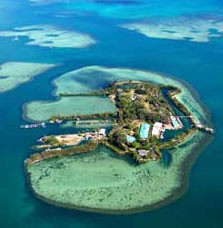
The Hawaii Institute of Marine Biology (HIMB) at Coconut Island
In 1912, a laboratory was established in a wooden structure on the shores of Waikiki with funds from the Charles M. Cook Estate. This laboratory functioned in association with the Waikiki Aquarium. In 1919, both facilities were turned over to the University of Hawai‘i. In 1947, the late Edwin W. Pauley provided an opportunity to establish a marine laboratory on Coconut Island, and the marine sciences entered into a new era in Hawai‘i. In 1993, the Pauley family again, in an act of far-reaching vision and generosity, provided funds to purchase the private portion of Coconut Island and construct a new world-class marine laboratory on the island.
For a more information on HIMB, including a complete history of Coconut Island, click here.

The laboratory and classroom buildings constitute and area of about about 14,000 square feet. Last year, the facility consumed more than 1.7 million kWh of electricity. The electricity bill for the facility last year was more than $250,000.
The problem: Although the laboratory building is relatively new, the air handling and other environmental systems consume more energy than necessary, and are literally rusting away and will need to be replaced soon. Occupants complain of being cold, and there are leaks in the celing which may be related to roofing problems.
Proposed solutions and activities: An entirely new set of air-handling, chilling, and heating equipment must be installed. Various technologies are being considered, including a ground-source heat pump using sea water. The first step will be to hire a commissioning agent to review the buildings' envelope, mechanical, electrical, and other systems for energy-savings opportunities and provide guidance and oversight for design and construction.
Click here for more information on what is involved in the commissioning and retrocommissioning of buildings and why it is so important for enhancing energy efficiency and making the best use of building environmental systems.
This project is in the preliminary stages, but could reduce electricity consumption by the new buildings by more than 40% below their current levels.
Labs for the 21st century is a voluntary partnership program dedicated to improving the environmental performance of U.S. laboratories. The University of Hawaii is a Center of Excellence for Marine-Based Laboratories for this program. The Labs21 site provides useful "how-to" information on designing, building, and maintaining world-class energy efficient laboratories, as well as case studies on laboratory construction and retrofits, conferences, trainings, and competitions.
Meters: The following is one week of output in April from Coconut Island's three meters.


